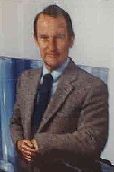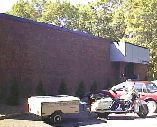Predicting the Future with Black Magic

Terry McDougall, Les Davis, Susan McLeod, Skip August and Julie Johnson
are helping to establish the first and only museum
displaying the history of the super computer.
Terry McDougall is one of those scientists, and his grandchildren will someday tell their children how their grandfather was a great scientist, how he helped change the world, and how he did it from a beautiful place called Chippewa Falls, Wisconsin. McDougall helped this team build the world's fastest computers, and these computers helped the world's scientists actually predict the future.
In the early sixties, McDougall learned computers first in the U.S. Navy, then with a company called Control Data. To give you an idea of what computers were like in 1964, let's look at the Control Data 6500. It was one of the first computers that had no vacuum tubes. It was a marvelous - incredible - machine that could whip through literally thousands of scientific calculations each second. This awesome device could replace hundreds of mathematicians with slide rules. Its efficiency was mind boggling, its accuracy was stunning and it would help send a man to the moon. It was on this machine that McDougall cut his binary teeth. Today this computer can be replaced easily by a handheld, scientific calculator.
Terry McDougall holds a thin, wafer ASIC
A man named Seymour Cray also worked at Control Data. Two things about Cray were that he was a brilliant scientist with exceptional ideas and that he knew very well that he was a brilliant scientist with exceptional ideas. When he could not act on those ideas, he reacted.
Seymour Cray knew how to push computers - and people - beyond their known limits.
Photo courtesy Chippewa Falls
Cray had an idea of a way to build a "super" computer. It involved faster hardware and faster methods of calculations, called vectoring. He found that he could not act on his ideas while working for Control Data, so, in 1972, he reacted by quitting and opening his own firm; Cray Research.
Cray recruited several engineers from his former employer, one of them being Terry McDougall, who went from the fairly routine job of checking computers before they left Control Data, to actually being a part of the computer design process at Cray. McDougall would be helping to design the biggest, fastest, most powerful computer in the world. That was their mandate, that was their achievement and that became their reputation for the next two decades.
"It was a very exciting time," McDougall says. "it was the right time. The seventies and eighties was when Cray Research bloomed and blossomed." It was a time when there was a definite need for super computers in the United States and around the world.
Cray computers are used, basically, to predict the future. Automobile manufacturers use Crays to simulate a vehicle crash and to learn how a car will "crumple" when hit. "Every auto manufacturer in the world has a Cray computer," says McDougall. Drug manufacturers use them to learn how drugs will affect us, and the weather services use them to study and forecast weather patterns. Millions of people around the world rely on Cray technology on a daily basis, technology that actually provides very simple calculations, just billions of them with remarkable speed.
So, you no longer have a car, but millions of items which will behave in their own way when going from sixty to zero in half a second. But, half a second is an extremely long time, as anyone who has slammed a foot on a brake pedal well knows, and you can divide that half second into many - perhaps hundreds - of sections.
So, if each "item" has, say, ten calculations related to it, you would have to make billions of calculations to understand the impact of a crash. This could all be done easily in exactly half a second by a teenager in his parent's Buick, or by a Cray super computer in, admittedly, a slightly longer time.
An explanation of the difference between the scientific calculations that a super computer does and what your personal computer does, if I were capable of providing one, might just put you to sleep right here. So let's just say that, even if you could put one of these multi-million dollar machines in your house, it would probably get less use than the sofa.
Seymour Cray was a Chippewa Falls native and he enjoyed working here. McDougall attributes the company's success in part to the small city, which even today has less than 13,000 people. "The salary is less, and the work ethic is stronger than in many places," McDougall says. "What else are you going to do here in January?" At least a bit of success can be be attributed to Leinenkugel's Beer and the frequent brainstorming sessions the local brew inspired.
Every late model car you drive was design tested
with the help of computers which were once made here,
in this rural building, where goats from nearby Frenchie's farm were known to wander the hallway.
In four years, the Cray team came out with their first computer, the Cray I. It shook the scientific world with its awesome speed and power. It stood seven feet tall, weighed five tons, had sixty miles of wiring and its own freon-charged refrigeration unit and could spit out calculations in only 12.5 nanoseconds - twice as fast as the competition. The Personal computer on your desk, made twenty years later, will still crawl far behind the Cray I, taking 30 nanoseconds to calculate, according to McDougall.
Working in their small brick building near Frenchie's Farm on the outskirts of town, Cray Research had the rapt attention of scientists around the world. They would build 57 of these machines, filling orders for the $7 million units just as fast as they could. Meanwhile, Seymour Cray kept up the research, designing a faster computer, one that would put him closer to his goal of a machine that would perform at teraflop speed.
"It was his (Cray's) job to design a computer and our job to make it work," says Skip August, a Cray engineer. "He'd say; 'I see no reason why that can't be done.' He usually gave us very little direct supervision, just challenges and goals."
"We would start designing each computer with a blank sheet of paper," says McDougall. Cray, a sailor who designed and built his own sailboats, believed in starting each project fresh. Legend has it that, at least on one occasion, he burned his old sailboat before designing his next one.
It took eight years for the Cray II to appear, but the wait was worth it. Half the size and weight of its predecessor, this machine cooked, with a speed of only 4.1 nanoseconds. Cooled by Flourinert, a human blood substitute, it was capable of slugging out 100 milliom operations each second. "It was black magic at the time," says McDougall. Scientists around the world quickly fell under its spell, paying $20 million apiece for 29 Cray II's.
Seymour Cray was not at all finished, though. He wanted nothing less than one trillion calculations per second - a goal toward which he would gladly stake everything.
The problem the Cray team faced was simple; resistance. When electricity flows through a conductor, it faces resistance, and that resistance creates heat. To reduce heat, the Crays I and II were built in a unique "C" shape. This was not for the sake of trademark, but to accommodate stacks of transistor laden boards as close together as possible and allow for the shortest wires possible - the Cray II had only seven miles of wire, but still used enough electricity to power 200 households.
Ways to overcome resistance and heat? First, make the components smaller. This has been done using ASICs, which today have 1.5 million gates on a wafer the size of your thumbnail. (A gate does the same switching operation as the transistor and vacuum tube.) Not only are the gates on an ASIC much smaller than individual transistors, but there is no need for miles of wiring between them.
After the Cray II, ASIC's were used, and Cray computers lost their "C" shape for more traditional towers about five feet tall. In 1993, McDougall led the team that designed the Cray EL 92, a "Desk side Super Computer," which stood less than three feet tall and sold for only $200,000.
Another way to reduce resistance is to use better conducting material. By the early nineties, Cray had built a large company and was facing tough competition. He needed more black magic, and he wanted to research a radical, new technology, but he could not get support from the very company he had built; Cray Research wanted to continue with the product they were already producing and selling. Cray wanted, as he always did, to design a better product. His solution was simple; quit and start another company.
Cray moved to Colorado Springs, Colorado and set up shop as Cray Computers, while McDougall stayed in Wisconsin. But the next few years were not good for Seymour Cray, and he went bankrupt several times. "He wasn't afraid of failure," says McDougall. "Expensive failures at that." In 1996, Cray was killed in an automobile accident, a tragedy not even his greatest machines could have predicted.
"It was a sad time for all of us," says McDougall. "It was really exciting working for him, and very enjoyable." It is clear that Cray was highly respected by his employees.
"I don't think I would have had any job that compared to what I had at Cray," says Skip August. "He'd take a chance on you. He would size you up and go with more of a gut feeling than your resume."
Silicon Graphics and Cray Research, where a picture is worth a thousand calculations and video images are worth millions.
In June of 1996, Silicon Graphics bought Cray Research for $750 million. Only six years earlier, Cray had considered buying Silicon Graphics, but decided to buy a company called Super Tek instead. SGI has moved their production facilities to Chippewa Falls - reliability of products made here is twice what the company had experienced in California, according to McDougall. The employee turnover rate had been 25% on the west coast, but is only 3% here. McDougall cites the scarce competition for jobs as the reason.
The Silicon Graphics, Cray Research marriage provides an exceptional combination. Cray computers can crunch some mighty numbers, and Silicon Graphics machines will take the Cray's output of reams of data and put it in an easier to comprehend, graphic form.
Years ago, Cray Research provided seed money to establish the Chippewa Falls Museum of Industry & Technology, which is now in its first year. Curated by Julie Johnson, under the guidance of Susan McLeod of the Chippewa Valley Museum, the museum houses several Cray and Control Data computers, and a display on the history of Chippewa Falls, which was once a logging center, with a beer brewery and factories for shoes, tires and woolens.
Technology has improved so greatly that Cray Research is finding that there is no need (or at least no demand) for liquid cooled computers, and has designed the SV1, an air-cooled machine that will satisfy a broader market.
Entrepreneurs have long wanted to offer videos over telephone lines, but how to handle requests for hundreds of movies at a time without having a room full of VCRs? The SV1 can actually play 200 digitized movies at once, in any order. It does this simply, like a card dealer (a very fast card dealer) sending out each frame so quickly, the viewer won't notice a gap.
Visiting the Cray Research facility in the Silicon Graphics building in Chippewa Falls, McDougall and I head for the development laboratory. We first step on an adhesive covered welcome mat to remove dirt from our shoes, then we enter the lab, which has complete climate control, antistatic flooring and appears to be a sterile environment, save Van Halen's "Jump!" blaring from the stereo.
In the rear of the lab is the last liquid cooled computer Cray Research plans to make. The T90 could figure a 15 percent tip, or convert dollars to rubles, in just two nanoseconds, and is 57 times more powerful than the Cray II - it is the closest thing yet to the Teraflop performer that was Seymour Cray's elusive goal. Without it's cosmetic cover, the T90 looks like a large ice cream wagon, with a shiny metal skin and heavy doors with chrome handles.
McDougall and I stare at the T90 through a clear, plastic wall, like new fathers outside a room of incubators. We watch the Flourinert bubbling through the display chamber and listen to the steady breathing of coolant fans. We stand quietly, looking at the last of a historic breed, the final member of a family of super computers that shared blood with humans.
 Friday, September 18, 1998, Chippewa Falls, Wisconsin -
They were not the best of the best, this group of scientists that changed our world. This was not the "dream team" of engineers, though they produced a machine most people could only dream about. No, they were simply very good scientists, who had the direction of a man who accepted nothing less than for them to be great.
Friday, September 18, 1998, Chippewa Falls, Wisconsin -
They were not the best of the best, this group of scientists that changed our world. This was not the "dream team" of engineers, though they produced a machine most people could only dream about. No, they were simply very good scientists, who had the direction of a man who accepted nothing less than for them to be great.

- more powerful than the 1960's era computer beside him.

Museum of Industry & Technology
How are Cray computers used?


Super Museum
Silicon Graphics computers have long been used to create special effects in motion pictures. One use for the SV1 being considered is to display motion pictures, namely movie videos. Imagine being able to watch your choice of hundreds - if not thousands - of movies at any time you wish.
 The Cray SV1, appearing soon
The Cray SV1, appearing soon
in living rooms everywhere.
Photo courtesy Cray Research
Check out the
True America Made in the U.S.A. Archives
Return to our
MAIN page
